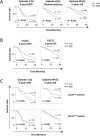Tissue and plasma levels of galectins in patients with high grade serous ovarian carcinoma as new predictive biomarkers
- PMID: 29038585
- PMCID: PMC5643335
- DOI: 10.1038/s41598-017-13802-5
Tissue and plasma levels of galectins in patients with high grade serous ovarian carcinoma as new predictive biomarkers
Abstract
Galectins are moving closer to center stage in detecting glycosylation aberration in cancer cells. Here, we have investigated the expression of galectins in ovarian cancer (OC) and examined their potential as biomarkers in tissues and blood plasma samples of high grade serous ovarian carcinoma (HGSC) patients. In tissues, we found that increased protein expression of stromal gal-1 and epithelial gal-8/9 was associated with a poor response to treatment of HGSC patients. Gal-8/9 were both independent predictors of chemoresistance and overall survival (OS), respectively. This galectin signature increased the predictive value of the cancer antigen 125 (CA125) on 5-year disease-free survival (DFS), post-chemotherapy treatment and 5-year OS. In CA125LOW patients, epithelial gal-9 was associated with a lower 5-year OS while stromal gal-1 and epithelial gal-8 were both associated with a lower 5-year DFS. Such negative predictive value of gal-8 and gal-9 was also found using plasma samples. In both cases, high plasma levels of gal-8 and gal-9 was associated with a lower OS and DFS. Overall, these data suggest that galectins may be promising biomarkers to identify subgroups of HGSC patients with poorer prognosis. Our study also contributes to better define the heterogeneity of the disease.
Conflict of interest statement
The authors declare that they have no competing interests.
Figures






References
Publication types
MeSH terms
Substances
LinkOut - more resources
Full Text Sources
Other Literature Sources
Medical
Research Materials
Miscellaneous

